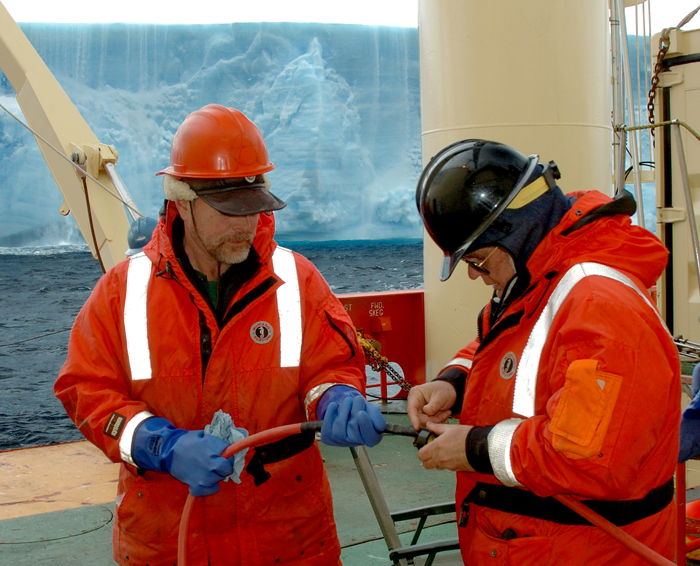|
Iceberg communities may play significant role in removing carbon“What we’ve done is just borrow that technology,” Smith said. “We got people at Scripps to build us several of these SOLO floats, and we secured inverted cones on them, so they’re like rain gauges. They just collect material as it settles through the water column. More Information
Related story: World of imagination
“The intent of that is to collect the carbon that is being produced by the community,” he added. “This gives us a handle on how much carbon is escaping the upper water system. We’re hopefully looking at how much carbon is being consumed by the enriched community, and how much of that carbon as organic matter is being exported out of the photic zone to the deep sea.” It’s in the photic zone where photosynthesis occurs, when sunlight penetrates the upper ocean. The high amount of phytoplankton biomass found around the icebergs in 2005 was similar to that found near the edge of seasonal pack ice or during iron enrichment experiments like that proposed by Martin, the scientists reported in the “Science” paper. Another key tool in the team’s arsenal is a remotely operated vehicle (ROV) tethered to the Palmer. Robison, the pelagic biologist, also from MBARI, is the primary ROV pilot. He said engineers have substantially modified the robot from when the scientists used it three years ago. They added two thrusters and a tool sled that allows the ROV to carry more instruments. They also upgraded its cameras, and outfitted it with a new, longer tether so the versatile little robot can explore the bottom of icebergs while the ship maintains a safe distance, about 300 meters. “It’s a little hairy getting too close to these big icebergs, because they calve and thousands of tons of ice can come falling into the ocean unannounced,” Robison said. “For those wanting to work in close, the only way to get in there, to see things and make measurements and collections, is with a remotely operated vehicle. “We’ve tricked it out with all types of gear,” added Robison, a co-principal investigator on the project. “When we got a peek around the corner [in 2005], so to speak, we couldn’t do any exploring underneath, and that’s something we’re looking forward to this time with the longer tether.” But thanks to the ROV in 2005, the team made another particularly provocative discovery, despite the robot’s limited range. They found “tufts” of algae adhering to the iceberg where sand-grain-sized volcanic rocks were embedded in the ice. In addition, the surface of the iceberg resembled a uniformly flattened golf ball, with the algae growing around the edges of the dimples, which were about 6 to 8 centimeters wide and about 2 centimeters deep. “It was a significant discovery. Something no one had seen before,” Robison said. “Krill were feeding on [the tufts of algae] extensively.” Added Smith, “There are huge fields of these things in the light zone.” The algae, made up mostly of diatoms, resembled that found in benthic communities in shallow subtidal zones. The scientists estimated that these algae might inhabit as much as 25 percent of the submerged portion of an iceberg. That represents a significant source of primary plant production — and another source for sucking CO2 out of the atmosphere — considering the number of icebergs floating along in the Southern Ocean. In fact, using satellite images, the researchers counted nearly 1,000 icebergs in an 11,000-square-kilometer area of ocean. They calculated that in 40 percent of the Weddell Sea the icebergs are raising biological productivity. It’s not unreasonable, Robison said, to hypothesize that icebergs are spawning similar productivity in other areas around the Southern Ocean. The idea seems incredible — that there are literally thousands of these floating estuaries sucking CO2 out of the air like a straw — until one considers what the researchers have already discovered. It all began with a simple observation, according to Robison. “One thing that you can’t help but notice is that anytime anything floats in the ocean — whether it’s a clump of seaweed or an old bottle or a wooden raft — eventually animal communities build up around it. Barnacles attach, some plankton goes there for shelter, and big fish hang out there to feed on the plankton,” he explained. “With the icebergs increasing, chances are that would have an effect on these pelagic communities,” Robison added. “These ideas come from lots of experience of looking at the ocean, scratching your head, and trying to figure out what’s going on and how does this work? And what am I missing?” Perhaps the better question to ask: What are they going to find next? NSF-funded research in this story: Ken Smith and Bruce Robison, Monterey Bay Aquarium Research Institute; and Timothy Shaw, University of South Carolina. |
"News about the USAP, the Ice, and the People"



For USAP Participants |
For The Public |
For Researchers and EducatorsContact UsU.S. National Science FoundationOffice of Polar Programs Geosciences Directorate 2415 Eisenhower Avenue, Suite W7100 Alexandria, VA 22314 Sign up for the NSF Office of Polar Programs newsletter and events. Feedback Form |


